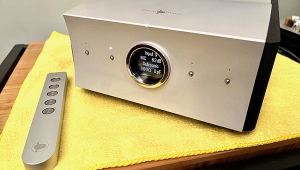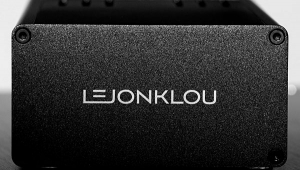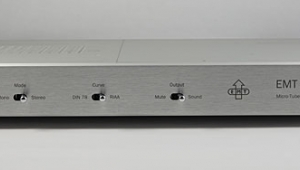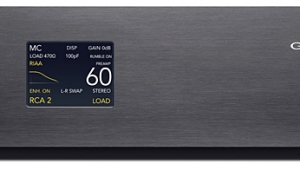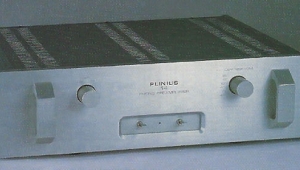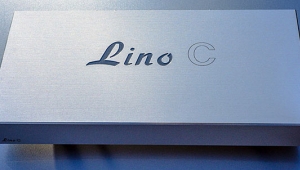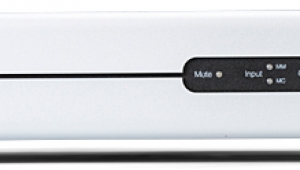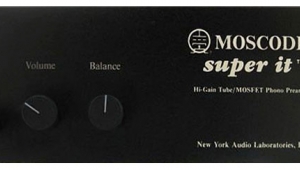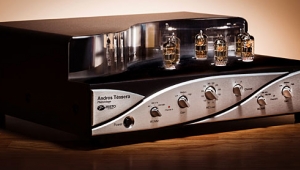| Columns Retired Columns & Blogs |
American Hybrid Technology phono preamplifier Measurements
Sidebar 3: Measurements
The measurements presented here for the American Hybrid Technology phono preamplifier were performed with a 47k ohm load in both the moving-coil and moving-magnet configurations. Additional measurements were made with a 100 ohm load resistor in the moving-coil configuration but are not presented here. They were not substantively different, except in one or two areas where our Audio Precision test set's 25 ohm source impedance into the 100 ohm load resistor was suspected of causing loading errors. (The source impedance of typical moving-coil cartridges is far lower than 25 ohms.)
The measured gain with the loading specified above was 39.9dB moving-magnet and 59.8dB moving-coil; somewhat lower than specified for the MM condition, but more than adequate in either case for most examples of either flavor of cartridge. The input impedance, as configured, measured just under 49k ohms (L&R) for moving-magnet at 1kHz and just over 46k ohms (L) and 48k ohms (R) for moving-coil. The preamp's output impedance measured 100 ohms (at 1kHz) for all intents and purposes (99.8 ohms left, 98.9 ohms right). The AHT is non-inverting, a positive-going input pulse emerging as positive at the output.
The AHT's RIAA response is shown in fig.1. Any comment would be superfluous, except to note that it is one of the flattest we've ever measured. The crosstalk in fig.2 is similarly exceptional for both configurations. Note that, except for the slight rise in right-to-left crosstalk (MC) above 10kHz, the high-frequency crosstalk actually decreases, indicating excellent decoupling of the two channels. (In most stereo electronic components, mutual capacitance between the left and right channels results in an increase in the high-frequency crosstalk.)

Fig.1 AHT phono preamplifier, RIAA error (right channel dashed, 0.5dB/vertical div.).
The AHT's THD+noise is also very low. Note that, while we generally try for a 0.5mV input in measuring a moving-coil input and 5mV for a moving-magnet, it almost never works out that way. The results for such low input levels are almost always dominated by noise. (This does not mean that the inputs are necessarily noisy per se, just that the noise portion of the THD+noise reading swamps the THD, making the reading less meaningful if we're interested in the actual THD.) Therefore we increase the input level until the 1kHz reading indicates a minimum or "saddle," rising with lower inputs due mainly to noise and rising again with higher inputs due primarily to THD. For the AHT, that point was 20mV for the moving-magnet configuration, 9mV for the moving-coil—the latter, especially, a very high value. (Note that these input levels were also used in measuring the crosstalk of fig.2, these readings being similarly sensitive to noise.)

Fig.2 AHT phono preamplifier, crosstalk (from top to bottom at 20kHz): RצL (MC), L–R (MC), RצL (MM), L–R (MM) (5dB/vertical div.) Measurement dominated by noise.
Fig.3 is a plot of the THD+noise results. The top pair of curves is for the moving-coil arrangement, the middle pair for the moving-magnet. The latter, as expected, is somewhat lower, but not dramatically so. I suspected that noise was still a significant portion of this result, since observing the THD+noise waveform on a 'scope indicated the presence of low-level, low-frequency components—60Hz and higher harmonics of that frequency. Plotting the curve again for the moving-coil configuration after inserting a 400Hz high-pass filter into the measurement chain produced the bottom curve shown in fig.3—a significant drop from the full-range measurement in the top curve—confirming my suspicions about noise playing a major role in this measurement. The filtered moving-magnet result is not shown, but is very close to that for the filtered moving-coil setup.
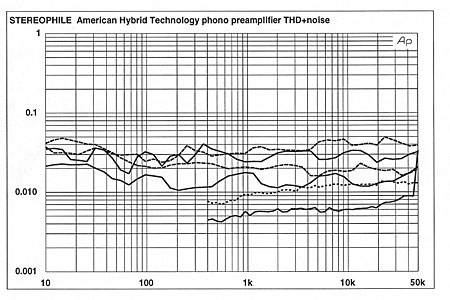
Fig.3 AHT phono preamplifier, THD vs frequency (from top to bottom): MC, MM, MC with 400Hz high-pass filter to remove hum (right channel dashed).
The AHT's overload margin is good. For moving-magnet, the 1% THD+noise level was reached at 92.5mV input (9.1V output) at 1kHz, 10mV input (9V output) at 20Hz, and 1.05V input (10.9V output) at 20kHz. The corresponding values for moving-coil are 10.6mV input (10.3V out) at 1kHz, 1.1mV input (9.9V output) at 20Hz, and 109mV input (11V output) at 20kHz. All overload readings were made with an unequalized input signal; the differences with frequency are due to the inherent nature of the RIAA curve (a much-lower-level signal is engraved in the equalized groove at 20Hz than at 20kHz). Taking the RIAA equalization into account, these figures are equivalent to overload margins of between 25.3dB and 26.8dB, which is excellent performance. However, when the AHT reached its overload points, it did so quite abruptly.
One peculiar aspect of the AHT's overload performance was observed only in the midband, and only in the moving-magnet configuration. After 1% THD+noise was reached, gradually backing off the input level from that point did not result in an immediate return to lower distortion levels. The THD+noise continued to increase until the input was dropped by several millivolts. This is more clearly depicted in Table 1. The measurement sequence runs from the top to the bottom of the table; the readings were taken at 1mV steps, though several are omitted here (they are not needed to make the point). Only the left-channel results are shown; the same observation was made on the right channel, with only slightly different results.
Table 1: THD+N at 1kHz, MM
| Input Level | THD+N |
| 87mV | 0.023% |
| 91mV | 0.023% |
| 92mV | 0.053% |
| 93mV | 1.45% |
| 92mV | 1.49% |
| 89mV | 1.74% |
| 87mV | 2.02% |
| 86mV | 0.023% |
In other words, the THD+noise level "sticks" at overload and is slow to recover. The output also began clipping asymmetrically on encountering overload, with the bottom of the waveform limiting first.
While unusual, this overload characteristic will never be encountered if you don't drive the inputs into overload—something you're unlikely to do with the AHT using phono pickups that have typical moving-coil or moving-magnet output levels. In all respects likely to be of audible significance, the AHT phono preamplifier's test-bench performance is excellent.—Thomas J. Norton
- Log in or register to post comments
